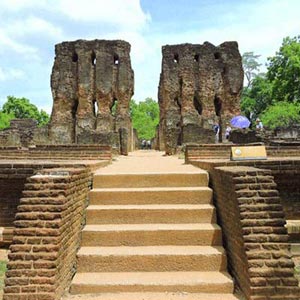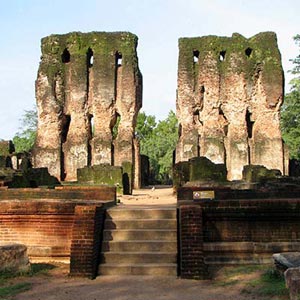


palace-of-ing-issankamalla
palace-of-ing-issankamalla-polonnaruwa
palace-of-ing-issankamalla-polonnaruwa-srilanka
Weijantha Prasadaya (Palace)
The Weijantha Prasada, a magnificent palace built with seven stories by King Parakramabahu and is said to have housed 1000 chambers. Although the initial construction may not have been able to hold such a large number of rooms, it is believed that there are possibilities that this was so considering the entirety of the palace and its extent.
In the present time what is left of this gigantic Weijantha Prasada are massive walls that is a meter thick and rises to about 30 feet. The bottom half of the main staircase which no doubt led to the upper floors, is another artifact that is visible today. Within the building are sections of melted brick walled, which came about by intense heat when the building was set fire to by Tamil invaders in the Polonnaruwa period. The main palace still has remains of constructions, that is believed to have been the living quarters of the ministers, soldiers and servants.
The large holes in the walls that are seen even today are said to have held up huge wooden structured that were a base to the floor of the levels above them. This palace has faced many destructions by humans as well as by mother nature over 800 years. However, the walls still depict plastering in certain sections. There is an architect’s impression of this once beautiful building which is no doubt an impression of what it would have been in the years gone by.
Relics and ruins such as the Weijantha Prasada or Palce of King Parakramabahu is ample proof of what ancient Sri Lanka was. Kings who reigned centuries ago, were an artistic lot and no doubt there would have been no machinery as in today’s era and most of these constructions would have been man-made.


